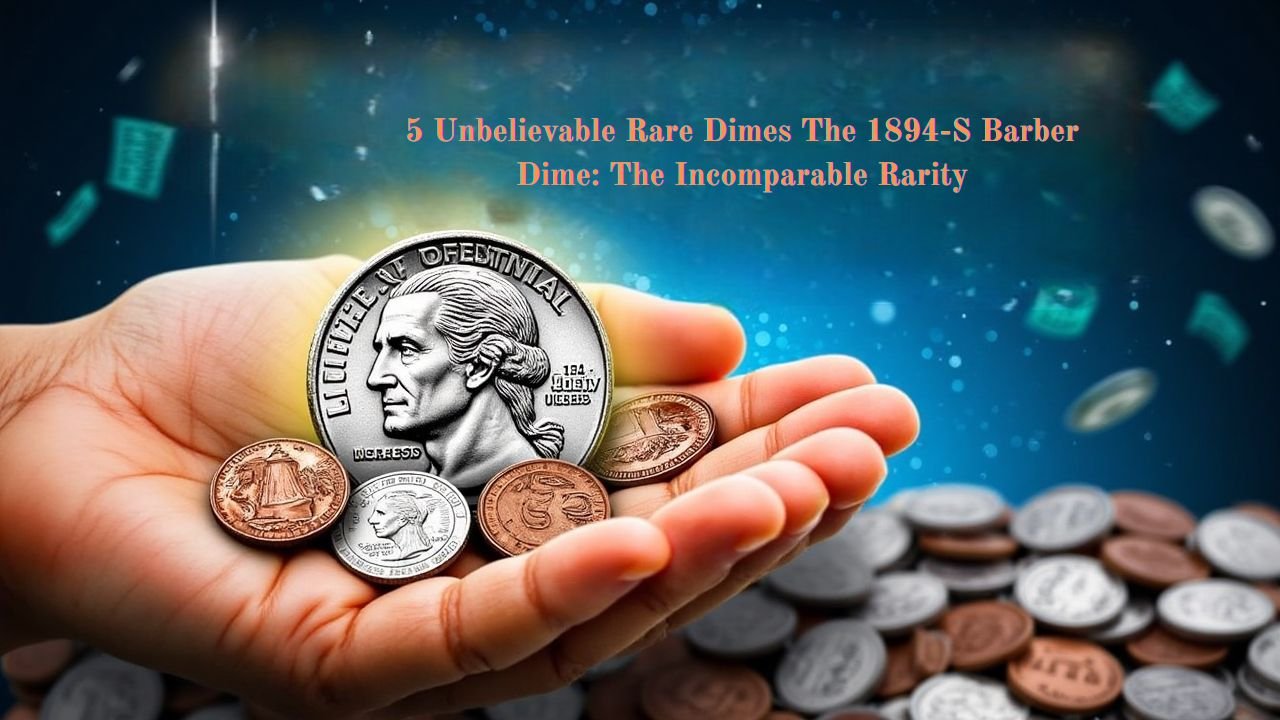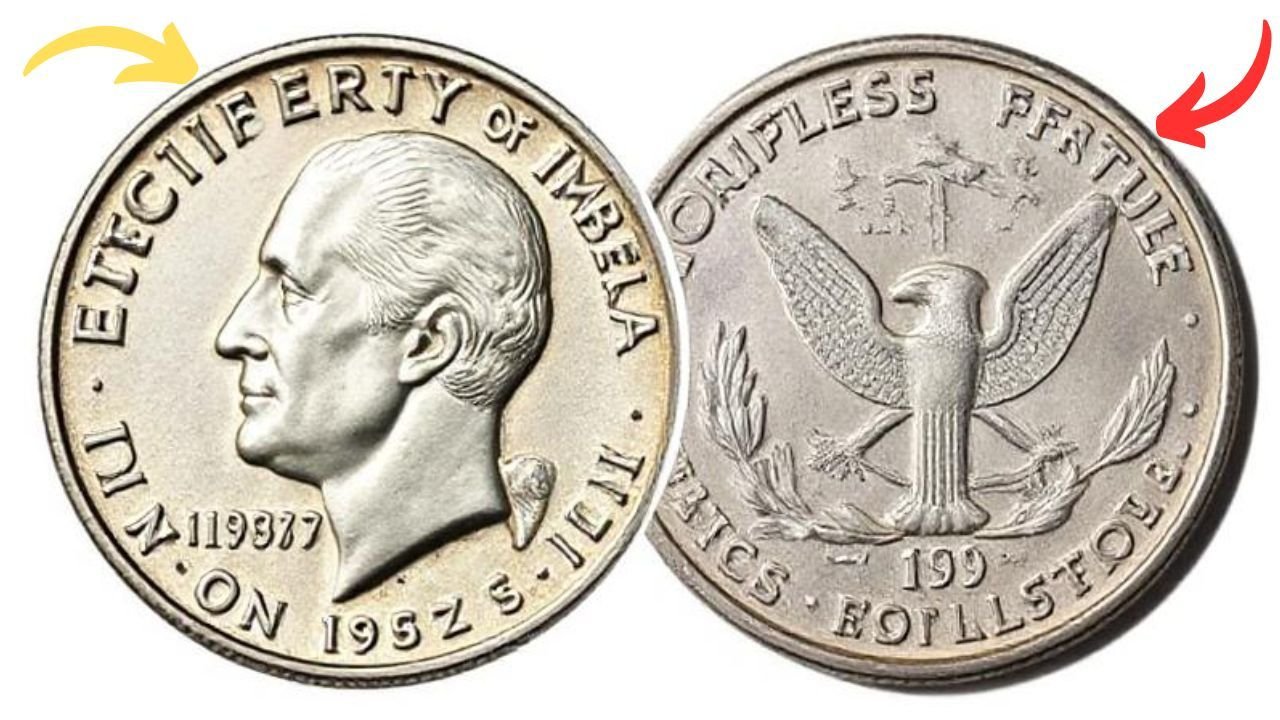5 Extremely Rare Dimes: Within numismatics, coins dare rare that become fairly legendary for their awesome rarity, historical significance, and enthralling stories behind their production.
While a majority of coins that are superlatively valuable might have long been found and secured either in museums or in private collections, six outstanding specimens—five dimes and a bicentennial quarter—are thought to be still in circulation, each estimated at around $250 million.
These coins constitute the grandest numismatic treasure hunt, perhaps changing hands in everyday transactions while worth enough to change the lives of whoever finds them.
5 Unbelievable Rare Dimes The 1894-S Barber Dime: The Incomparable Rarity
The 1894-S Barber dime is possibly the most renowned rarity among American coins, with an incredible backstory that has mesmerized collectors for generations.
The Mint in San Francisco had produced only 24 dimes in the year 1894, out of which only nine confirmed specimens are known to exist today. The surrounding context of this minuscule mintage has spawned all manner of theories and tales.
One very convincing story has it that 24 dimes were made on direct order by John Daggett, San Francisco Mint Superintendent, to allow the annual accounts of the mint to balance.
According to numismatic lore, he had given three of these dimes to his daughter Hallie, on the condition that she keep them until she was older.
Supposedly, she bought ice cream on the way home and, with that, spent one of the coins she would become an unwitting custodian of.
“The 1894-S represents the perfect confluence of factors that create extraordinary value,” Dr. Eleanor Hughes, senior numismatic curator at the National Coin Archives, said.
“Extreme rarity combined with a mysterious origin story and impeccable documentation of its production make it uniquely compelling to serious collectors.”
Although the majority of known cases are housed in large museum collections or in private collections, at least one example is believed to be in circulation, having been spent by an heir of a collector ignorant of its true value.
In uncirculated condition, it is worth about $250 million; a heavily worn example would still be worth tens of millions if discovered in someone’s pocket change.

The 1975 No-S Proof Dime: Modern Impossibility
Not only will the rarity of this dime be worth nearly anything, but it is also one of the most valuable modern coins; a coin that shouldn’t exist.
There are a few trivial exceptions, but in general, all proof coins-that are produced by special minting for a collector with a die for highly polished coins on polished blanks-have mintmarks on them, denoting the producing mint. All 1975 proof dimes would carry an “S” mintmark for the San Francisco Mint.
However, a small number were mistakenly without this critical mintmark.
The exact number is not known, but numismatic experts guess that fewer than 10 were struck before the error became detected and corrected.
Only two specimens have been authenticated by major grading services, at least one of which is believed to be still in circulation due to someone breaking up what they did not know was a proof set.
“Perhaps the most important modern error from the mint, the 1975 No-S proof dime, says Victoria Russell in her book America’s Million-Dollar Coins.
“Proof coins are subjected to so many quality checks that very few, if any, would even be able to get by such checks with this kind of error,” she said of the miracle of its production.
Last auction-this coin sold for over 1.3 million-about a decade ago; experts believe now, that in light of the skyrocketing values of ultra-rare coins, the piece might easily command around $250 million, given its renown as probably the greatest modern American mint error.
The Microscopic Marvel: 1916 “Doubled Die” Mercury Dime
When the Mercury dime design supplanted the Barber series in 1916, there was a dramatic minting error that was undiscovered for decades.
A misalignment at the hub-to-die stage produced what numismatists now recognize as the most outrageously dramatic doubled die in the series-parallel obverse design doubling that is particularly conspicuous in Liberty’s profile and the date.
“What makes this doubled die so special is the combination of its dramatic visual impact along with being on a first-year-of-issue design,” said error coin specialist James Williamson.
“The doubling is very evident even to the naked eye having that almost three-dimensional effect that is unmistakable once you know what to look for.”
Numismatic researchers think around 15-20 were struck before detection of the error, almost all entering circulation before the variety was officially documented.
Only three specimens have been confirmed by major grading services, but experts believe at least one may still be in circulation, possibly mistaken for a normal 1916 Mercury dime by its current owner.
With auction records for lesser doubled dies exceeding $1 million, specialists case this landmark error at about $250 million for a well-preserved example, although even heavily worn pieces would command eight figures if discovered.
The ‘Special Struck’ Silver Dime: An enigma of 1964
Reflecting toward the change from silver to clad compositions in 1965, a few experimental dimes produced in the year 1964 had special striking features: neither business strikes nor normal proofs, but with careful finishing techniques considered for future collector coins.
Such coins were struck with extraordinary care using specially prepared dies and planchets and exhibited bright magnified fields, frosted devices, and fine exceptional detail.
It relates to the developmental work that eventually led to the Special Mint Sets offered to collectors from 1965-1967 during the coin shortages.
According to a well-known numismatist Jonathan Williams, “These 1964 special striking dimes illustrate the gap in American numismatic history. They produced the gap between traditional silver coinage and the new clad age, while experimentally illustrating techniques never fully adopted for regular production.”
Most stayed inside the Mint, but records say that some five coins were among those presented in sets to officials of the Treasury.
At least one of these dimes is suspected to have been placed into circulation after being taken from its original holder.
Given their unique historical importance in a pivotal moment of American coinage history, these transitional pieces are valued at something close to $250 million by specialists.
The wartime oddity: the “Copper-Nickel” Experimental Dime of 1942
Real-time experimenting with various metals by the U.s mint was carried on under a strategic move to chestall the metals to the war effort during the periods of World War II.
Although the general public, including collectors, knows well about the one steel cent in 1943, hardly anyone realizes that the Mint had produced certain experimental dimes with a copper-nickel composition similar to what would later be adopted for clad coinage in 1965.
These pattern pieces were struck in order to try out how a copper-nickel mixture would do in the dime denomination should such a thing ever become necessary because silver became too rare for use in creating money.
According to Mint records, all examples supposedly were destroyed once their test was complete. But again, dig through numismatic literature, and you will find evidence showing that at least three specimens got out.
Robert Chen, metallurgical consultant to the major auction houses, states, “These experimental wartime patterns represent an important chapter in American numismatic history.”
“Their existence demonstrates contingency planning occurring as the treasury department prepped for a potential metals shortage.”
One of these copper-nickel experimental dimes was found in a bank roll in 1959 and eventually disappeared into a private collection.
At least one further example is believed to remain in circulation, identifiable by specific copper-nickel coloration rather than the silver appearance of standard dimes.
Considering their value in history as well as their extreme rarity, these pieces would be worth about $250 million.
The Impossible Combination: the 1976 ‘Silver’ Bicentennial Quarter
The last in this phenomenal array is the 1976 “Silver” Bicentennial quarter with no mintmark at all.
The Mint struck these quarters with an extra special 40% silver for collectors only during America’s bicentennial celebration and gave them all the “S” mintmark standing for the San Francisco facility.
Normal circulation quarters were struck in copper-nickel clad composition at both Philadelphia (no mintmark) and Denver (“D” mintmark).
However, numismatists have documented at least two examples of bicentennial quarters lacking mintmarks that were struck on 90% silver planchets-an impossible combination that should not exist.
These error coins combine circulation-strike (no mintmark) characteristics with a silver composition exceeding even that of collector versions at 40% silver content.
“This composition error represents perhaps the most miraculous mint mistake of the modern era,” states James Thompson, bicentennial coinage specialist.
“Systems were built to separate production of silver and clads, so such crossover could not have happened, making these error coins particularly valuable.”
It is believed that at least one example of this 90% silver bicentennial quarter without mintmark is still in circulation, passing unknown from hand to hand.
For many specialists, because this bicentennial coinage is of such historic value and this error is so spectacular, they might value the coins at 250 million dollars approximately.

This guide has been valid for everything learned about dimes up to October 2023.
A numismatic expert can suggest the following to anyone lucky enough to find one of these wonderful rarities:
- Narrowly concentrate one’s attention: Dimes truly worthy of note would be those minted in 1894-S, 1916, 1942, 1964, and also in conjunction with the 1975 quarters.
- Use magnification: A 10x loupe or digital microscope will see the very most important details such as missing mintmarks or doubled features.
- Checking the weight and composition: The 1942 copper-nickel experimental dime and silver bicentennial quarter would differ in weight and appearance as compared with regular issues.
- Look for incredibly sharp details: The 1964 special striking dime is an example of extreme detail found in a well-worn coin.
- Get it certified by an expert: If you truly feel you have something special, then contact a reputable numismatic authority.
While the odds of finding anything in everyday change that is worth about $250 million remain through-the-roof probability-wise, these six coins remind us that real value will sometimes lie there in plain sight, waiting for that perspicacious someone to discover it for a lifetime’s worth of worth.
FAQS:
Is it true that those rare dimes and that Bicentennial Quarter are worth $250 million apiece?
While a few very rare dimes and Bicentennial Quarters might fetch hefty amounts, such claims must be validated through authentic numismatics sources and auction records.
What makes these coins so valuable?
The value of these coins is derived from their rarity, mint errors, historical significance, and demand from collectors. Some of the crucial components include low mintages, unusual errors, and pristine conditions.
What differentiates these coins as valuable? .
I have one of these rare coins? Check for specific mint marks, dates, and possibly errors such as double die strikes or missing elements. Use a magnifying glass and check a coin value guide.
Are these rare coins yet in circulation?
Occasionally, rare coins turn up in circulation, but they are very rare. Most valuable dimes and quarters are sold in collections or at auctions.
Where will I get my coin appraised?
You can visit trusted numismatist organizations, recognized coin dealers, and grading services like PCGS (Professional Coin Grading Service) and NGC (Numismatic Guaranty Company).

